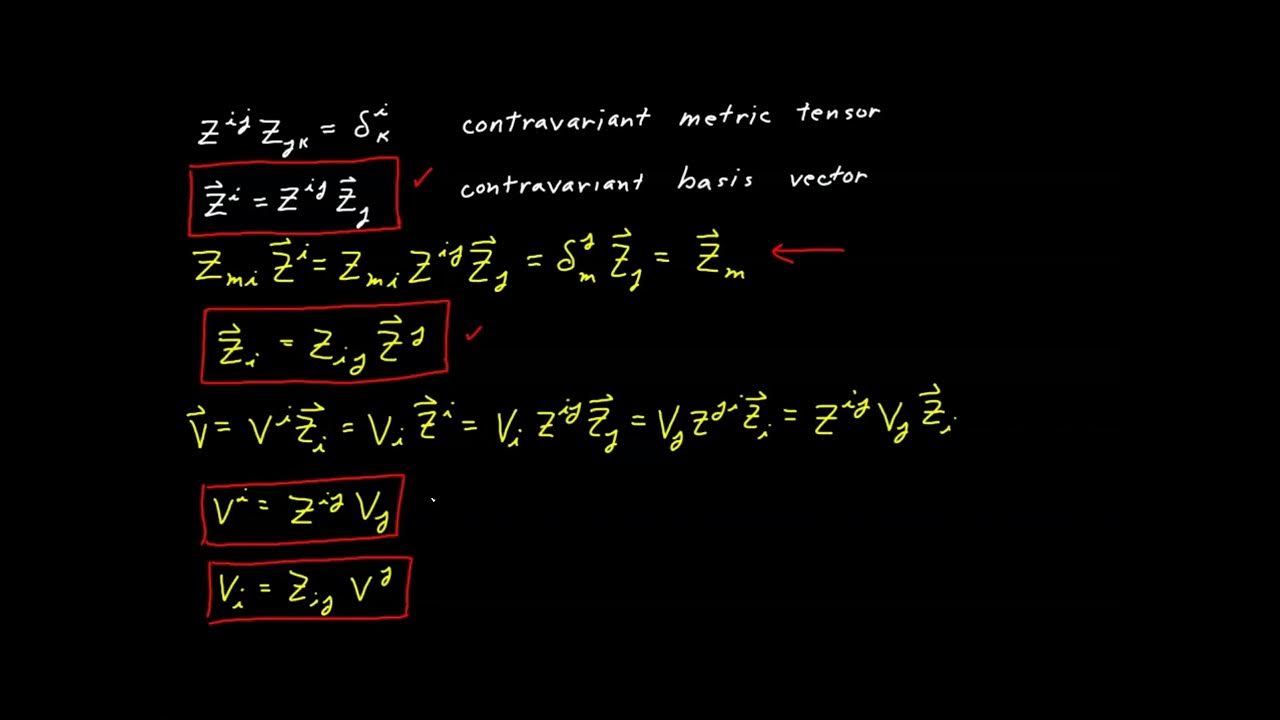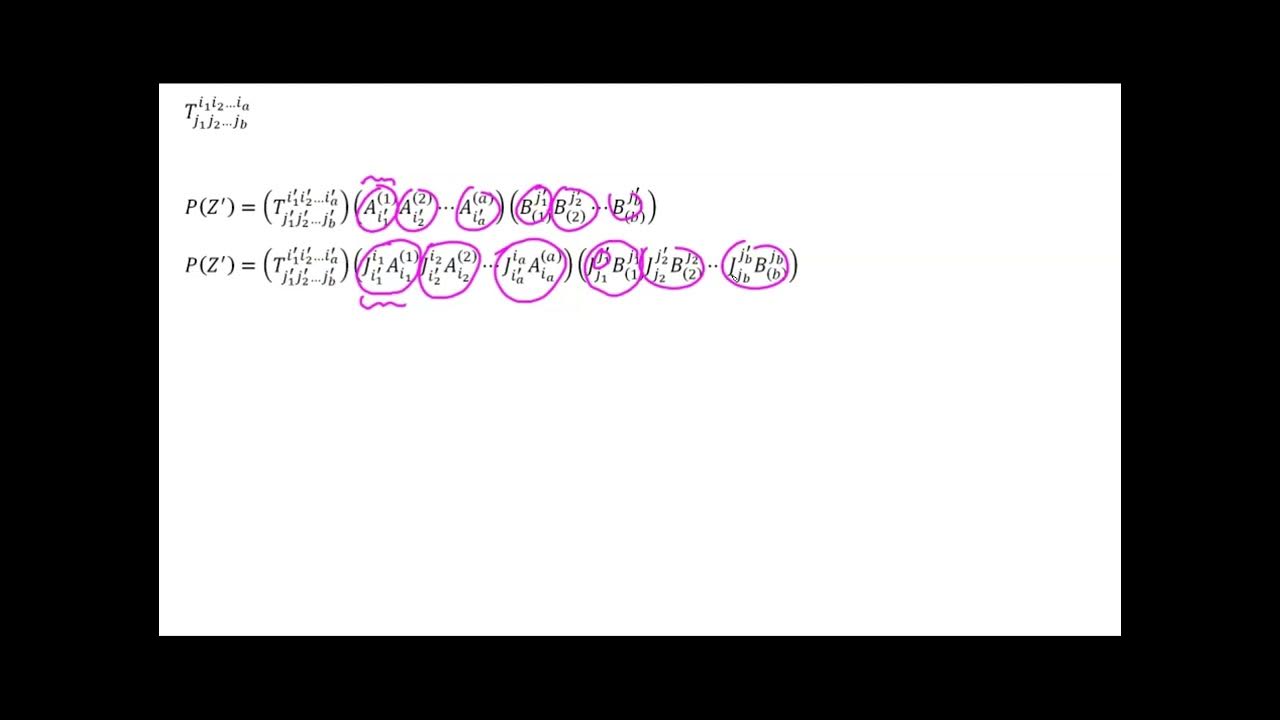Tensor Calculus For Physics Ep 8| The Metric pt. 3 |Covariant and Contravariant Vectors
TLDRIn this comprehensive episode of 'Tensor Calculus for Physics,' the host concludes the basics of tensor calculus, covering vector and dual conversions, tensor transformation rules, and the proof of the metric tensor as a true tensor. The video delves into contravariant and covariant vectors' relationship with ordinary vectors, introduces tensor algebra operations, and explores how integration measures transform with coordinate systems, linking Jacobians to the metric tensor. This dense content is aimed at viewers eager to grasp the fundamentals of tensor calculus for advanced physics applications.
Takeaways
- 📚 The video concludes the basics of tensor calculus, preparing for more advanced topics like derivatives of tensors and covariant derivatives.
- 🔄 The script explains how to convert between vectors and duals, introducing the concept of the inverse metric tensor to revert from dual to regular vectors.
- 🧩 The transformation rules for tensors with lower indices are discussed, including how to apply these rules to tensors of various lengths.
- 📏 The metric tensor is proven to be a tensor itself by demonstrating that the space-time interval remains invariant under coordinate transformations.
- 🔢 The script delves into the relationship between contravariant, covariant vectors, and ordinary vectors in orthogonal Euclidean spaces, emphasizing the preservation of the scalar product.
- 📉 The concept of tensor algebra is introduced, covering operations such as scalar multiplication, tensor addition, tensor contraction, and tensor product.
- 📚 The rank of a tensor is defined as the sum of its contravariant and covariant indices, which dictates how the tensor transforms.
- 🤔 The video script raises the question of how operations like gradient, curl, divergence, and Laplacian behave under tensor calculus, hinting at topics for future videos.
- 🤓 An example is given to demonstrate tensor contraction, showing that contracting a tensor with itself results in a scalar.
- 📈 The transformation of integration measures, such as the Jacobian, is related to the metric tensor, with the Jacobian being the square root of the determinant of the metric.
- 🔍 The script suggests that future videos will explore tensor densities and volume elements, indicating further development of the topic.
Q & A
What is the main focus of the video on tensor calculus for physics?
-The main focus of the video is to wrap up the very basics of tensor calculus, covering various small topics such as converting vectors and duals, transformation rules for tensors with lower indices, proving the metric tensor is indeed a tensor, discussing tensor algebra, and how integration measures transform.
How can you convert a dual vector back to a regular vector?
-To convert a dual vector back to a regular vector, you need to apply the inverse of the metric tensor to the dual vector. This process involves defining the inverse metric with upstairs indices and using it to transform the dual indices into regular indices.
What is the significance of the metric tensor in tensor calculus?
-The metric tensor is significant as it is used to convert between vectors and their duals, and it also plays a crucial role in defining the transformation rules for tensors with lower indices. The video also discusses proving that the metric tensor is indeed a tensor.
What is meant by 'raising and lowering indices' in the context of tensors?
-Raising and lowering indices refers to the process of converting a tensor's index from a covariant (downstairs) to a contravariant (upstairs) form, or vice versa. This is done by applying the metric tensor or its inverse, respectively.
How does the transformation rule for tensors with downstairs indices differ from those with upstairs indices?
-The transformation rule for tensors with downstairs indices involves placing the displacement terms in the denominator, whereas for tensors with upstairs indices, the displacement terms are in the numerator. This ensures the tensors transform correctly under coordinate transformations.
What is the relationship between covariant, contravariant vectors, and ordinary vectors?
-Ordinary vectors are the coefficients of the basis vectors in an orthogonal system. Contravariant vector components are related to the ordinary vector components by dividing by the scale factor (H_mu), while covariant vector components are related by multiplying with the scale factor.
What is tensor algebra, and what are its main operations?
-Tensor algebra is the set of operations that can be performed on tensors, including scalar multiplication, tensor addition, tensor contraction, and tensor product. These operations allow for the manipulation and combination of tensors in various ways.
How do you prove that the metric tensor is a tensor?
-To prove that the metric tensor is a tensor, one can consider the space-time interval, which should be invariant under coordinate transformations. By showing that the metric tensor transforms according to the rules of a second-rank tensor, its tensorial nature is confirmed.
What is the significance of the Jacobian in the context of integration measures?
-The Jacobian is significant in the context of integration measures because it relates the differential elements of integration in different coordinate systems. It is used to transform integration measures correctly when changing coordinate systems.
How is the Jacobian related to the metric tensor?
-The Jacobian is related to the metric tensor through the transformation rules of the metric tensor. The square of the Jacobian is equal to the ratio of the determinant of the metric tensor in the unprimed frame to the determinant of the metric tensor in the primed frame.
What is the role of the Kronecker Delta in tensor operations?
-The Kronecker Delta is used in tensor operations to simplify expressions and change the indices of tensors. It acts as a selector that is equal to 1 when its indices are the same and 0 otherwise, which can be useful in tensor contractions and transformations.
Outlines
📚 Wrapping Up Basics of Tensor Calculus
The speaker introduces the final topics in the basic concepts of tensor calculus for physics. Key points include converting vectors to duals and vice versa using the metric tensor and its inverse, discussing transformation rules for tensors with lower indices, proving the metric tensor is indeed a tensor, and explaining tensor algebra operations like addition, contraction, and tensor product. The speaker also mentions future topics such as tensor densities and integration measures transformation.
🔄 Converting Vectors and Duals with Metric Tensors
This section delves into the process of converting between vectors and dual vectors using the metric tensor. The speaker explains how to find the dual of a vector by applying the metric tensor and how to reverse the process using the inverse metric tensor. An example using cylindrical coordinates is provided to illustrate the calculation of the metric tensor with upstairs indices and its inverse.
🔗 Transformation Rules for Tensors with Lower Indices
The speaker discusses the transformation rules for tensors with lower indices, extending the concept from vectors to tensors of various ranks. The explanation includes how to properly sum over indices using Einstein summation and how displacements in the transformation equations need to be handled differently for tensors with downstairs indices compared to those with upstairs indices.
📏 Proving the Metric Tensor as a Tensor
The speaker aims to prove that the metric tensor is a tensor by considering the space-time interval's invariance. The process involves expanding the interval in terms of the metric tensor and coordinate differentials, transforming the coordinate differentials, and showing that the metric tensor follows the transformation rule for a second-rank tensor.
🧭 Contravariant and Covariant Vectors in Orthogonal Systems
The section explores the relationship between contravariant and covariant vectors and ordinary vectors in orthogonal systems, such as Cartesian, cylindrical, and spherical coordinates. The speaker explains how contravariant vector components are related to the ordinary vector components by dividing by the scale factor, and covariant components are related by multiplying by the scale factor. The importance of preserving the scalar product form is highlighted.
🌐 Gradient in Spherical Coordinates
The speaker discusses the gradient operator in spherical coordinates, explaining how it relates to the derivative of a scalar field. The components of the gradient are derived by considering the metric tensor for spherical coordinates and how the gradient's components change with respect to the basis vectors' lengths.
🔢 Tensor Algebra Operations
This part covers the four main algebraic operations that can be performed on tensors: scalar multiplication, addition, tensor contraction, and tensor product. The speaker provides examples of each operation, explaining how they affect the rank and components of the tensors involved.
📐 Jacobians and Integration Measures Transformation
The final topic of the script is the transformation of integration measures, such as the Jacobian in coordinate transformations. The speaker explains how the Jacobian is related to the metric tensor, demonstrating that it is the square root of the ratio of determinants of the metric tensors in different coordinate systems.
Mindmap
Keywords
💡Tensor Calculus
💡Metric Tensor
💡Dual Vectors
💡Transformation Rules
💡Covariant and Contravariant
💡Tensor Algebra
💡Kronecker Delta
💡Einstein Summation Convention
💡Jacobians
💡Spherical Coordinates
💡Gradient Operator
Highlights
Wrapping up the basics of tensor calculus, preparing for advanced topics like derivatives of tensors and covariant derivatives.
Introduction to converting vectors to duals and vice versa using the metric tensor and its inverse.
Defining the inverse metric tensor with upstairs indices and its role in transforming dual vectors to regular vectors.
Example of converting vectors in cylindrical coordinates using the metric tensor.
Explanation of transformation rules for tensors with lower indices and how they relate to vector transformation.
Proof that the metric tensor is indeed a tensor through the invariance of the space-time interval.
Distinguishing between contravariant and covariant vectors and their relationship with ordinary vectors in orthogonal systems.
Derivation of the relationship between contravariant vector components and ordinary vector components.
Discussion on the definition of covariant vector components and its relation to the metric tensor.
Visual explanation of contravariant and covariant vectors through changing basis vector lengths.
Application of the relationship between covariant, contravariant, and ordinary vectors in spherical coordinates.
Introduction to tensor algebra, including operations like scalar multiplication, addition, and tensor contraction.
Example of tensor contraction resulting in a scalar and its transformation properties.
Exploring the rank of tensors and how it affects their transformation.
Demonstration of the relationship between the Jacobian matrix and the metric tensor in coordinate transformations.
Conclusion on the significance of the Jacobian in transforming integration measures and its connection to the metric tensor.
Announcement of future topics, including tensor densities, volume elements, and their transformations.
Transcripts
5.0 / 5 (0 votes)
Thanks for rating:





